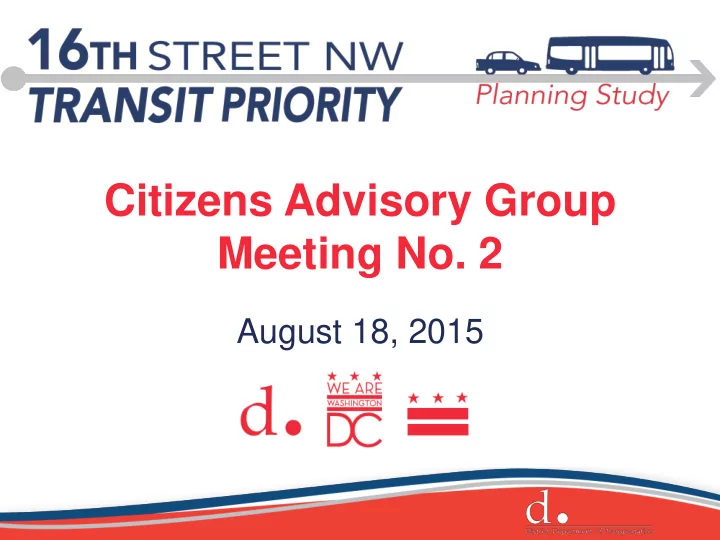

Citizens Advisory Group Meeting No. 2 August 18, 2015
Agenda 1. Introduction 2. Data Sources 3. Transit Existing Conditions 4. Next Steps 5. Discussion
INTRODUCTION
Study Area Arkansas Avenue NW Primary Study Area • 16 th Street NW from H Street to Arkansas Avenue 16 th Street NW Secondary Study Area • Bounded by 14 th Street, 18 th Street, Taylor Street and H Street H Street NW
Project Timeline Data Selection of Project Alternatives Collection & Preferred Kickoff Development Analysis Alternative
Recap from Last Meeting • Existing Conditions Transit Data – Additional data collected in June • Multimodal Traffic Analysis – Updated over the summer to incorporate Downtown Signal Optimization • Public Kick Off Meeting • Physical Conditions Assessment
Overall Process • Travel speeds Identify problems • Reliability along the corridor Identify improvements that address problems Formulate alternatives
Stop Dwell / Doors Open Time? • Off-board fare collection • All-door boarding 3 minutes 1.5 minutes <1 minute
Signal Delay? • Signal priority • Queue jump opportunities
Slow Travel? • Strategic use of bus lanes • Queue jump opportunities
Enforcement? • Automated Enforcement
Other Improvements? • Service Plans • Articulated Buses • Number & Location of Bus Stops
Development of 3 Alternatives Physical Operational Service Improvements Improvements Improvements • Simplify service patterns • Bus lanes • Automated enforcement • Off-board fare • Queue jumps payment • Transit signal priority • Bus stop relocation and • All-door boarding access improvements • Bus zone improvements • Stop consolidation • Traffic operations • Skip-stop service • Parking restrictions • Fleet changes
DATA SOURCES
Primary Transit Data • AVL/APC Data (WMATA) – October to December 2014 • On-Board Data – March and June 2015 – Doors Open Times – Other Delays – Boardings and Alightings
Additional Transit Data • Study Area Bus Lines Patterns • Frequency by Line by Hour • Scheduled Service Spans • Scheduled Miles Hours Trips History • Stop by Route/Line Variation • Average Weekday Boardings and Alightings • Ridership by Time Period • Transfers • Bus Loading and Loading Duration • On-Time Performance • Time Distance - Typical Days and Monthly Average • Headway Variation - Reliability • Travel Speed By Time of Day and Segment
Multimodal VISSIM Model Data • Multimodal Counts and Signal Timing – Provided by DDOT TOA – Incorporated April Downtown Signal Optimization • Bus Operations – Dwell times taken from on-board data – Frequency based on published schedule
Additional Data • Pedestrian access and safety • Roadway configuration and curbside uses • Bus stop zones and amenities
TRANSIT EXISTING CONDITIONS
Corridor-Level Findings 1. Bunching 2. Total Trip Times 3. Travel Speeds by Time of Day 4. Boardings and Loads 5. Average Bus Operations
Bunching • Buses are already bunched in the AM and PM Peak before they reach the study area • All AM Peak, Midday, PM Peak and Early Night (7-11pm) bus routes have poor headway adherence = frequent bus bunching or most buses are bunched • S2 performs worst of all lines in SB AM Peak and NB PM Peak
Existing S Lines • Multiple service patterns contribute to bunching
Total Trip Times • Actual trip times are longer than the scheduled trip times, which contributes to bunching • Total trip time is longer in SB AM Peak than NB PM Peak
Travel Speed by Time of Day • Travel speed slowdown in AM and PM extends past peak period • Off-peak speeds are slow too – NB speeds are slower in Early Night (7 - 11 PM) than in PM Peak – Midday S1/S2/S4 speeds are not significantly faster than peak period peak direction speeds • Off-peak parking contributes to slowdown
Boardings and Loads • Boarding and alighting time per passenger is lower for S9 compared to S1/S2/S4 – S9 has low-floor buses for easier boarding • Maximum loads and percent of time load exceeds seated capacity are high on all lines – Highest % in peak periods is S4 – Contributes to longer doors open time and pass- bys
Average Travel Operations (Source: On-board Data Collection) Overall Peak Period Peak Direction Averages Doors Open Time 20% 53% Signal/Stop Delay Before Loading Delay Congestion Delay & Other Delays 22% Bus in Motion 1% 5%
Comparison Merging Signal/ at Bus Bus in Stop Stops Motion Delay 20% 34% Bus in 21% Motion Doors Signal/ 54% Open Stop Doors Time Delay Open 22% 27% Time 18% NJ TRANSIT Route 10 – MTA NYCT M15 – Kennedy Boulevard First Avenue/Second Avenue
Segment Analysis
Development of 3 Alternatives Physical Operational Service Improvements Improvements Improvements • Simplify service patterns • Bus lanes • Automated enforcement • Off-board fare • Queue jumps payment • Transit signal priority • Bus stop relocation and • All-door boarding access improvements • Bus zone improvements • Stop consolidation • Traffic operations • Skip-stop service • Parking restrictions • Fleet changes
NEXT STEPS
Next Steps • Early Fall: Existing Conditions report finalized • Early September: Alternatives development • Late September: Interagency and CAG Meetings • October: Alternatives shared at public awareness events • End of Year: Preferred alternative selected
DISCUSSION
Recommend
More recommend